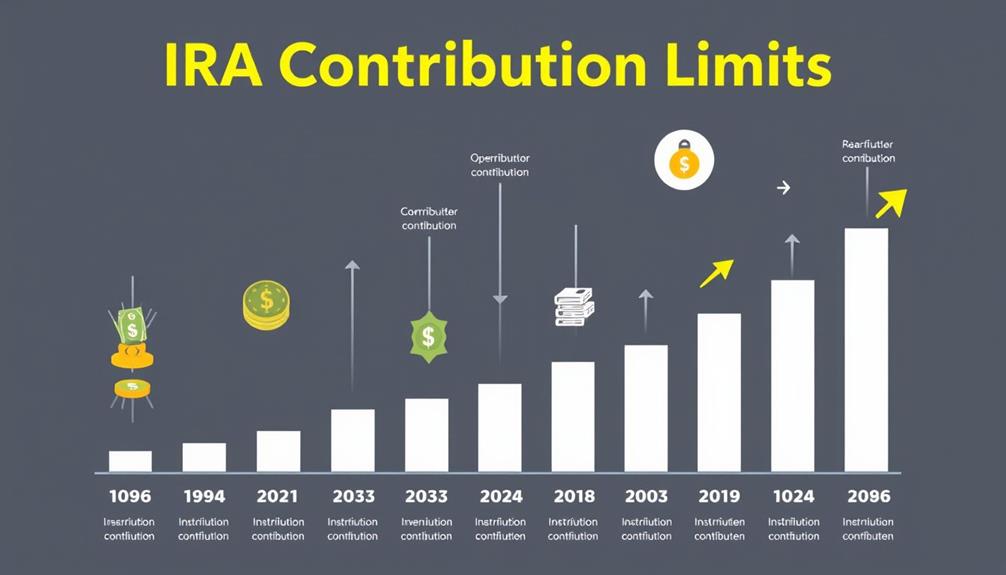A Self-Directed IRA (SDIRA) enables you to explore a variety of investment options beyond traditional stocks and bonds, including real estate, cryptocurrencies, and precious metals. This flexibility provides you with more control over your retirement savings and the possibility for higher returns. It is essential to have an IRS-approved custodian to manage compliance and record-keeping for your investments to ensure they adhere to regulations. Additionally, understanding the unique benefits of Traditional and Roth SDIRAs can help you maximize your tax advantages. By selecting the right investment strategy, you can significantly strengthen your portfolio. Learn how to establish your SDIRA and unlock its full potential for your retirement plans.
Key Takeaways
- Self-Directed IRAs allow investments in alternative assets like real estate, cryptocurrency, and precious metals, providing greater portfolio diversification.
- Setting up an SDIRA requires choosing an IRS-approved custodian and completing an application for either Traditional or Roth accounts.
- Traditional SDIRAs offer tax-deferred growth, while Roth SDIRAs allow for tax-free withdrawals after a 5-year holding period.
- Investors retain control over their assets, enabling quick decision-making and tailored investment strategies aligned with personal goals.
- Compliance with IRS regulations is crucial to avoid penalties, making accurate record-keeping and understanding prohibited transactions essential.
What Is a Self-Directed Ira?

A Self-Directed IRA (SDIRA) gives you the freedom to invest in a diverse range of assets beyond just stocks and bonds, such as real estate, cryptocurrency, and precious metals. Unlike Traditional SDIRAs or Roth SDIRAs, which limit you to conventional investment options, an SDIRA opens the door to alternative investments, allowing you to diversify your retirement funds considerably.
This diversification is vital for mitigating risks, especially during economic volatility, and can also include options like a Gold IRA which provides a hedge against inflation and market downturns.
To manage your SDIRA, you'll need to work with an IRS-approved custodian, who guarantees compliance with regulations and maintains accurate records of your transactions for tax reporting. This added responsibility means you have greater control over your financial assets, which can lead to the potential for higher returns.
However, keep in mind that investing in an SDIRA also comes with increased risks and complexities. It's essential to be aware of prohibited investments—like life insurance and collectibles—because engaging in non-compliant transactions can result in severe penalties from the IRS.
Investment Options Available

Exploring the investment options available through a Self-Directed IRA (SDIRA) can greatly enhance your retirement portfolio. Unlike traditional IRAs, SDIRAs allow you to invest in a wide array of alternative assets, including real estate investments, precious metals, and even crowdfunding investments. This flexibility opens up numerous investment opportunities that can help you diversify your holdings.
For instance, investing in precious metal IRAs can provide a hedge against inflation and market volatility.
With an SDIRA, you can purchase both residential and commercial properties, generating rental income that remains tax-deferred until you withdraw it. You can also include precious metals like gold, silver, platinum, and palladium, as long as they meet IRS purity standards and are stored in an approved depository.
Additionally, SDIRAs permit you to engage in crowdfunding investments, which can provide access to startups or real estate projects with lower minimum investment thresholds, though they may carry higher risks.
Setting Up Your Self-Directed IRA

Setting up your Self-Directed IRA (SDIRA) is a straightforward process that can empower you to take control of your retirement investments. By considering options like a Gold IRA, you can diversify your portfolio and protect against market volatility, as these alternatives often provide a hedge against inflation and economic downturns Gold IRAs offer benefits.
Here's how to get started:
- Choose an IRS-approved custodian: Look for one that specializes in alternative investments and review their fees and services.
- Complete your application: Decide whether to establish a Traditional or Roth SDIRA based on your tax preferences and retirement goals.
- Fund your SDIRA: You can do this through contributions or rollovers from existing retirement accounts. Remember, the annual contribution limits for 2024 are $7,000 (plus a $1,000 catch-up for those 50+).
Once you've funded your SDIRA, you can start exploring a variety of investment options, including real estate, precious metals, and cryptocurrency.
Just make sure your investments comply with IRS regulations. It's essential to maintain accurate transaction records and regularly monitor your investments to guarantee compliance and optimize your retirement savings strategy.
With these steps, you're well on your way to leveraging alternative investments for a more diversified retirement portfolio.
Traditional Vs. Roth Self-Directed IRAS

When choosing between Traditional and Roth Self-Directed IRAs, you'll want to evaluate how each impacts your taxes and withdrawals.
Traditional SDIRAs let you contribute pre-tax dollars, while Roth SDIRAs use post-tax dollars, affecting your current and future tax situations.
Additionally, the rules around withdrawals differ greatly, so understanding these nuances is essential for your retirement planning.
Contribution Tax Treatment
Understanding the contribution tax treatment of Traditional and Roth Self-Directed IRAs (SDIRAs) is essential for making informed retirement planning decisions. Here's what you need to know:
- Tax Treatment: Traditional SDIRAs allow contributions with pre-tax dollars, giving you a tax deduction for the contribution year. In contrast, Roth SDIRAs require after-tax contributions, meaning you won't get a tax deduction now.
- Contribution Limits: For both Traditional and Roth SDIRAs, the standard annual contribution limit is $7,000, with an extra $1,000 catch-up contribution available for those aged 50 and older.
- Income Limits: There are no income limits for Traditional SDIRAs, making them accessible to everyone. However, Roth SDIRAs impose income limits of $161,000 for single filers and $240,000 for married couples filing jointly.
While Traditional SDIRAs grow tax-deferred, you'll owe taxes upon withdrawal in retirement.
Roth SDIRAs, on the other hand, offer tax-free withdrawals after a 5-year period, provided you meet specific conditions. Knowing these details can help you choose the right Self-Directed IRA for your retirement strategy.
Withdrawal Rules Comparison
Steering through the withdrawal rules for Traditional and Roth Self-Directed IRAs can greatly impact your retirement strategy.
With a Traditional Self-Directed IRA, you must begin taking Required Minimum Distributions (RMDs) at age 73, which can affect your taxable income. In contrast, Roth Self-Directed IRAs don't require RMDs during your lifetime, offering more flexibility in managing your funds.
If you need to access your money early, be cautious. Early withdrawals from a Traditional Self-Directed IRA before age 59½ incur a 10% penalty, but you can withdraw your Roth contributions anytime without penalty.
Additionally, after a 5-year holding period, you can enjoy tax-free withdrawals of earnings from a Roth Self-Directed IRA, while Traditional withdrawals are taxed as ordinary income.
It's also essential to note that if you become disabled, you can make penalty-free withdrawals from a Roth Self-Directed IRA, unlike the stricter conditions of a Traditional Self-Directed IRA.
Understanding these rules can help you optimize your retirement savings and choose the right Self-Directed IRA for your financial needs.
Benefits of Self-Directed IRAs

Self-Directed IRAs offer you a unique chance to explore diverse investment opportunities, from real estate to cryptocurrencies.
You'll enjoy significant tax advantages that can boost your retirement savings, whether you choose a Traditional or Roth option.
Plus, having control over your investments means you can make decisions quickly, taking advantage of the best opportunities as they arise.
Diverse Investment Opportunities
With a Self-Directed IRA, you can tap into a world of diverse investment opportunities that go beyond the limitations of traditional retirement accounts.
This flexibility allows you to build a retirement portfolio tailored to your interests and market insights.
Here are three key benefits of diversifying your investments:
- Alternative Investments: You can invest in real estate, cryptocurrency, precious metals, and private equity, which often provide higher returns than traditional stocks and bonds.
- Control Over Investment: Unlike conventional IRAs, you have greater control over your investment choices, empowering you to make informed decisions that align with your financial goals.
- Tax-Deferred Growth: Your investments grow tax-deferred until withdrawal, maximizing your retirement wealth potential.
Tax Advantages Explained
Tax advantages play an essential role in making Self-Directed IRAs a compelling option for retirement savings. With Traditional IRAs, you can enjoy tax-deferred growth, allowing your contributions, made with pre-tax dollars, to accumulate without immediate tax liability until you withdraw funds. This delay can greatly enhance your investment potential over time.
On the other hand, Roth SDIRAs offer the allure of tax-free withdrawals of earnings after a 5-year holding period. Since contributions are made with after-tax dollars, you won't face taxes on your earnings during retirement, maximizing your financial gains.
In 2024, the contribution limit for SDIRAs is set at $7,000 annually, plus an extra $1,000 for those aged 50 and over, further boosting your tax-advantaged retirement savings.
Additionally, your investments can include alternative assets like real estate and cryptocurrency, which can yield higher returns, enhancing the overall tax benefits of these accounts.
Control Over Investments
Investors gain unparalleled control over their investment choices when utilizing Self-Directed IRAs. With a Self-Directed IRA, you can explore a world of alternative assets, allowing you to diversify your portfolio like never before.
Here are three significant benefits of having complete control over your investments:
- Tailored Investment Strategies: You can align your investments with your personal interests and expertise, tapping into unique opportunities that could lead to higher returns.
- Direct Management: You don't have to rely on financial institutions for every decision. This direct management allows for quick responses to market changes, keeping you ahead in the investment game.
- Checkbook Control: By setting up an LLC, you gain checkbook control, letting you execute transactions directly without custodian delays, enhancing your investment agility.
With a Self-Directed IRA, you're empowered to make informed decisions that align with your financial goals.
The ability to harness alternative assets not only mitigates risks associated with traditional market volatility but also opens doors to potentially lucrative investment avenues.
Take control of your retirement and watch your financial future flourish!
Common Mistakes to Avoid

Maneuvering through the complexities of self-directed IRAs can be intimidating, and avoiding common mistakes is essential for safeguarding your investments.
One critical error is engaging in prohibited transactions, like investing in collectibles or dealing with disqualified persons, which can lead to hefty IRS penalties. Always conduct thorough due diligence; alternative investments require more knowledge than traditional options, and failing to understand them can result in poor investment choices.
Another mistake is misunderstanding the liquidity of alternative investments. You might find yourself in a cash crunch when you need funds for required distributions.
Keep accurate records of all transactions and valuations to simplify tax reporting and maintain your IRA's tax-advantaged status. Neglecting this can complicate compliance and jeopardize your benefits.
Understanding Custodian Roles

When you're maneuvering through the world of self-directed IRAs, understanding the role of a custodian becomes vital. A custodian is a required entity that guarantees compliance with IRS regulations while managing your account.
Here are three key responsibilities they hold:
- Transaction Execution: Custodians execute investment transactions, guaranteeing all actions align with IRS rules to avoid penalties.
- Record-Keeping: They maintain accurate records of all transactions, which is important for tax reporting and compliance.
- Account Management: Custodians hold the title to your assets and provide support in accessing alternative investments.
Choosing the right custodian can greatly affect your investment options and overall account management. Not all custodians are created equal; their fees, experience, and range of available alternative investments can vary greatly.
Opt for an IRS-approved custodian who understands your goals and can guide you through the complexities of self-directed IRAs. By guaranteeing proper compliance and reliable support, a good custodian helps you access the potential of your Self-Directed IRA while safeguarding your retirement assets.
Frequently Asked Questions
What Are the Cons of a Self-Directed Ira?
You might face significant risks with a self-directed IRA, including high fees that cut returns, liquidity issues when selling investments, and the overwhelming complexity of managing various assets and ensuring compliance with IRS regulations.
Can I Trade Options in My Self-Directed Ira?
Trading options in your Self-Directed IRA is like maneuvering through a maze; it's possible but tricky. You can trade publicly traded stock options, but make certain you follow IRS guidelines and choose the right custodian to avoid pitfalls.
What Are the Restrictions on a Self-Directed Ira?
Your self-directed IRA has restrictions like avoiding collectibles, life insurance, and S-Corporations. You must also steer clear of transactions with disqualified persons and guarantee all investments maintain fair market value to avoid penalties.
What Kind of IRA Allows for Alternative Investments?
You can explore alternative investments through a Self-Directed IRA (SDIRA). This type of IRA broadens your investment options beyond stocks and bonds, allowing you to engage in real estate, cryptocurrency, and more.
Conclusion
In the vast sea of retirement planning, a self-directed IRA is your sturdy vessel, allowing you to navigate through alternative investment waters. By understanding your options and avoiding common pitfalls, you can steer your financial future toward greater growth. Embrace the freedom and control a self-directed IRA offers, and watch as your retirement dreams take shape. With the right approach, you're not just saving; you're crafting a legacy that can flourish for years to come.










